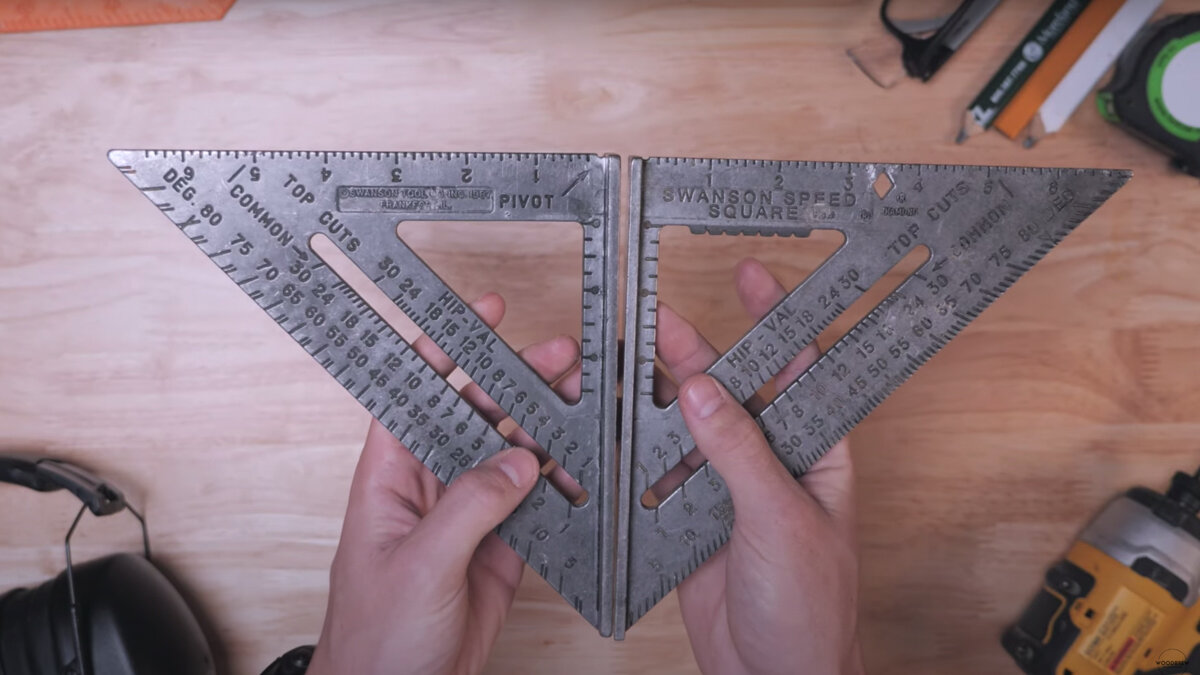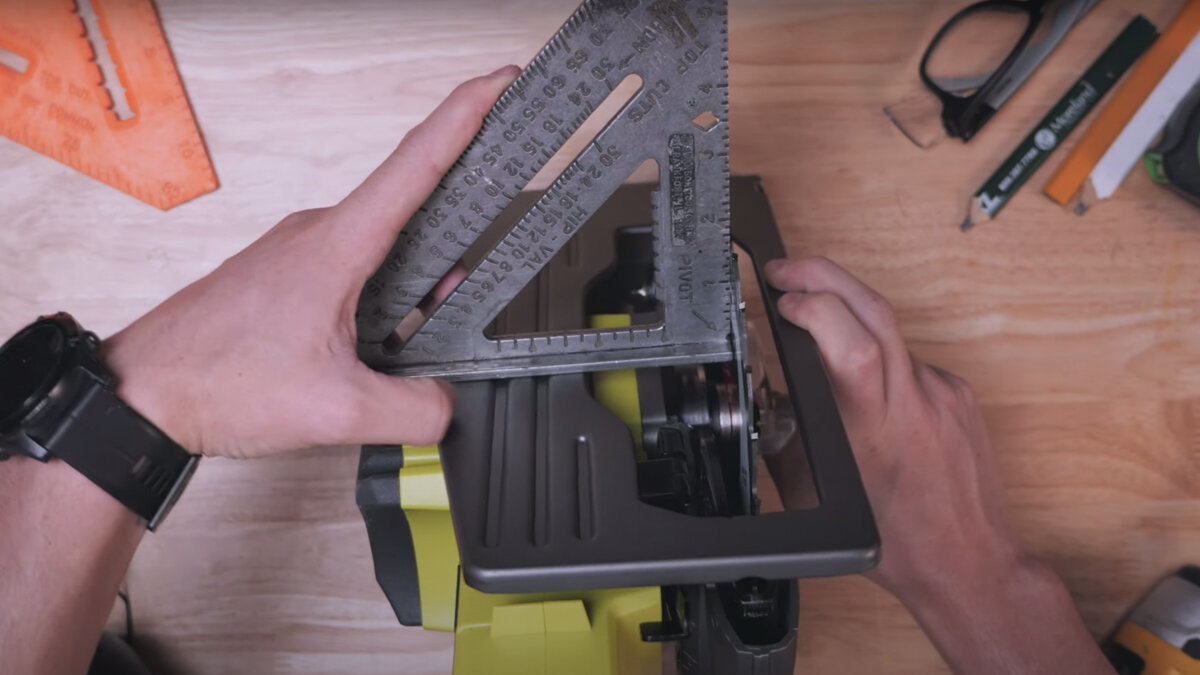How to Use a Speed Square | The Basics
If you've ever spent much time on a construction site or watching YouTube videos on making things, chances are you've seen a speed square. These triangular devices have been used by makers for decades. Originally invented by Albert J Swanson in 1925, Swanson Speed Squares (affiliate link) have become a household name and it's the square that Dylan grew up learning to woodwork as well. If you are new to woodworking it can be daunting to figure out what tools you may or may not need. There is just a ton of information out there. Which is a good thing, but it's a lot to take in. Hopefully, in this blog, we can show you how to use a speed square to its full potential.
All the Different Kinds of Speed Squares
Here is the image that pops up when you think of a speed square. This one here is an all-aluminum speed square (affiliate link) and what made the household name, Swanson and currently holds the copyrighted name of "speed square".
There are many differences between speed squares, so let's start there. The one on the left is a 20-year-old Swanson, and the one on the right is a newer one that we use daily. They are basically identical but have a few differences like the diamond cut out in the newer one and the scribe lines in the inner triangle. We are going to show you what you can do with these features here, but keep in mind that a lot of squares don't come with said features.
Another thing about the Swanson Speed Square is that they all come with the Swanson Speed Square Blue Book. This book gives you a lot of conversions and shows you everything you need on how to use the speed square. In the back of the book, it gives you all the measurements you need for making rafters, you find the length and width of your building and there ya go. This book goes way more into detail than what we are talking about today, just thought this was super interesting.
Here is a larger Swanson speed square at 12" (affiliate link) , and this one is made out of a composite material and is their "speedlite" model. Even though these are super nice and light and easy to use, ours has chipped and is broken in the middle. Just something to keep in mind.
Moving onto another 12" speed square, this one is all aluminum from Empire (affiliate link). This one large scribe marks designed for using the carpenter pencils, doesn't work so good with a regular pencil or pen. Another thing is on the back, it has a nice common rafter conversion chart with runs and degrees. This one isn't really the best for us, we don't build buildings, so the chart or the larger scribe marks aren't a selling point in our case, but it could totally be for you.
This one is a bit different. This all aluminum speed square from Husky (affiliate link) is a bit thicker than most of the squares out there. It's also painted with white lettering which is nice and different, but not to sure about how long the paint will last over time. This one does have nice scribe lines that will work better with a regular pencil or pen. One downside to this one is that it doesn't go the full 7", it goes to a little over 6" which you can barely tell because there isn't a 6 on the square. This can be tricky and will show you why later on. The unique thing about this one though, it extends to turn into the full 12". One thing to keep in mind though is that if you were to drop this on the ground, you might risk bending the extendable part out of square, and then now what's the point. This is super handy though if you are looking into only buying 1, and now you wouldn't have to buy a 7" and a 12".
Most Common Uses
The most common use of a speed square is creating a square line. Simply hold the square against the long edge, you can draw a straight, square line. You can hold the square either from the top or bottom, really just personal preference, we both typically hold it from the top.
Still in this position, you can use that inner opening to make multiple marks using the guide there, and then move the square down the board to make another line. This would be a great layout tool for putting a wall stud in place. If you have a top and bottom plate, you can just transfer those lines and that's the reason for the length of a square. Now those plates are going to be identical.
You can also use the scribes to make straight lines down the board, just line up the scribe mark to the measures above.
Beyond 90° Angles
Let's move beyond 90° angles. Say you want a simple 45° angle. All you have to do it turn the square to where the angled side is lined up with your mark.
Now say you want a different angle. Any angle on a 180° plane. On this square is actually says pivot. So place that point (the 90° point on a square) on your mark. Now, pivot the square until your desired angle is lined up with the board. This one is a 15° angle.
What if you need one beyond 90°? This can also be achieve with a speed square! Let's do 105° angle. So, 90 + 15 is 105, make you're 15° mark, but now looking at it from the bottom of the board past 90° to your 15° mark, that's 105°. All in all, subtract 90 from the total angle you want and use that number to make your mark.
Using a Speed Square for Power Tools
Moving away from boards for a second, another really practical use for a speed square is using it for your saw. You should almost alway make sure your saw blade is square. For instance, with a circular saw, making sure there is no power going to the saw, you can push the blade guard back and making sure the blade is square to the bed of the saw. You can do this with any saw as well!
Another thing to think about and check is to make sure the square is actually square. All you have to do is make a 90° line, then flip the square over and make sure that line is lining up right with no gaps. This is just something to look for every now and then.
You can use a speed square as a guide for power tools, mostly done with a circular saw and man is this easy! You can use a square instead of measuring out the perfect line and clamping down a guide rail.
Speed Square for Construction and Roofing
Now let's talk about roof structure and the speed square. This is what a house structure looks like, not to scale, but it gives you the picture. This roof has a 6:12 pitch meaning that every 12" of run, there is 6" of rise. That pitch correlates to the angle of the rafter that hits the ridge. This 6:12 pitch is a 26 1/2° angle. If the pitch was 12:12, the angle would be 45°. Here's how you would line up the speed square to create that angle. The numbers labeled as common are your pitches, so number 1 would be 1:12, 2 is a 2:12.....ours is 6:12, so tilting the speed square until we get to 6, now you have the right angle you can mark and cut. I'm not sure how well I can explain the birdsmouth section in words, so I am going to refer you to the video at the top which this part starts at 17:30.
That's going to do it for this "How to Use a Speed Square" blog! I hope you got some good information here and you can refer to the video at any point if you get confused. I am such a visual learner that no matter how well you explain something to me, I will not understand until I visually see it in action.















